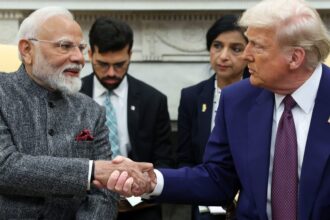The United States is planning to impose new tariffs on Indian exports starting in April. This means Indian companies selling goods to the U.S. may have to pay extra charges, making their products more expensive and less competitive. Experts at Citi Research estimate that India could lose around $7 billion per year due to these new tariffs.
The reason behind this move is that India already charges higher import taxes on U.S. goods. In 2023, India’s average tariff rate was 11%, which is 8.2 percentage points higher than what the U.S. charges on imports. The U.S. government sees this as unfair and is considering applying similar tariffs on Indian products.
Indian officials are trying to find ways to reduce the impact. They are working on plans to negotiate a trade deal with the U.S. that could lower tariffs on both sides and encourage more trade between the two countries.
However, certain industries in India are at higher risk. Sectors like chemicals, metals, jewellery, automobiles, pharmaceuticals, and food products could suffer the most. These industries rely heavily on exports to the U.S., with India sending goods worth $74 billion to the U.S. in 2024. This includes $8 billion from pharmaceutical companies and $4 billion from food product companies. If tariffs increase, these industries may struggle to sell their products in the U.S. market.
On the other hand, U.S. exports to India are worth around $42 billion. However, American companies already face higher tariffs when selling their products in India. For example, U.S. food products face import duties of nearly 68% in India, while farm goods are taxed at 30% – far higher than the 5% rate in the U.S.
If the U.S. decides to increase tariffs on Indian agricultural products, it could badly affect Indian farmers and food exporters. Even though trade volumes in this sector are lower, the difference in tariff rates makes Indian goods vulnerable. Industries like textiles, leather, and wood products may not be as severely affected since they have a smaller share in U.S.- India trade.
The worst-case scenario would be if the U.S. applies a flat 10% tariff on all Indian goods and services. This could slow down India’s economy, causing an estimated drop of 50-60 basis points in growth and reducing imports by about 11-12%, according to Standard Chartered Bank.
To reduce tensions and maintain good trade relations with the US, India has already started lowering some tariffs. The duty on high-end motorcycles has been reduced from 50% to 30%, and on bourbon whiskey from 150% to 100%. India has also promised to review other tariffs, increase energy imports, and buy more defense equipment to ease trade concerns.
To counter this same challenge, India may also try negotiating with the U.S. to lower tariffs on some American goods, especially food products. Another option could be increasing import duties on luxury goods that are not essential, while keeping export products competitive. India could also encourage more U.S. businesses to invest in the country, creating stronger trade ties and balancing the situation.
In short, if these tariffs are imposed, it could hurt Indian businesses and exporters. The government is looking for solutions, but trade negotiations with the U.S. will be key in deciding the final impact.







